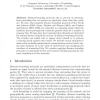Free Online Productivity Tools
i2Speak
i2Symbol
i2OCR
iTex2Img
iWeb2Print
iWeb2Shot
i2Type
iPdf2Split
iPdf2Merge
i2Bopomofo
i2Arabic
i2Style
i2Image
i2PDF
iLatex2Rtf
Sci2ools
ESAS
2006
Springer
2006
Springer
So Near and Yet So Far: Distance-Bounding Attacks in Wireless Networks
Distance-bounding protocols aim to prevent an adversary from pretending that two parties are physically closer than they really are. We show that proposed distance-bounding protocols of Hu, Perrig and Johnson (2003), Sastry, Shankar and Wagner (2003), and Capkun and Hubaux (2005, 2006) are vulnerable to a guessing attack where the malicious prover preemptively transmits guessed values for a number of response bits. We also show that communication channels not optimized for minimal latency imperil the security of distance-bounding protocols. The attacker can exploit this to appear closer himself or to perform a relaying attack against other nodes. We describe attack strategies to achieve this, including optimizing the communication protocol stack, taking early decisions as to the value of received bits and modifying the waveform of transmitted bits. We consider applying distance-bounding protocols to constrained devices and evaluate existing proposals for distance bounding in ad hoc net...
| Added | 22 Aug 2010 |
| Updated | 22 Aug 2010 |
| Type | Conference |
| Year | 2006 |
| Where | ESAS |
| Authors | Jolyon Clulow, Gerhard P. Hancke, Markus G. Kuhn, Tyler Moore |
Comments (0)

